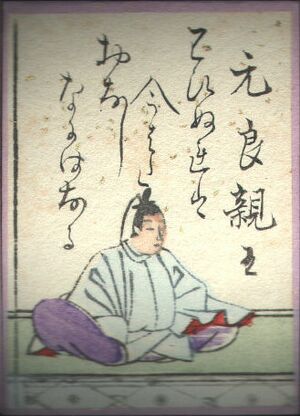Prince Motoyoshi facts for kids
Prince Motoyoshi (元良親王, Motoyoshi shinnō, 890-July 26, 943) was an important person in ancient Japan. He lived during the Heian period, a time when emperors ruled and art, especially poetry, was very popular. Prince Motoyoshi was known as a talented poet and a high-ranking nobleman.
He was the oldest son of Emperor Yōzei. This made him a prince with a special place in the royal family. He had several wives, including princesses from other important emperors like Emperor Daigo and Emperor Uda.
Who Was Prince Motoyoshi?
Prince Motoyoshi was born in 890 and passed away in 943. He was a member of the Japanese imperial family. During the Heian period (794 to 1185), noblemen like him played a big role in society and culture.
His Poetry
Prince Motoyoshi was especially famous for his poems. Poetry was a very important art form in the Heian period. People used poems to express feelings, share thoughts, and even communicate messages.
One of his poems is included in a very famous collection called the Ogura Hyakunin Isshu. This book features 100 poems by 100 different poets. His poem is number 20 in this special collection.
Twenty of his poems were also chosen for another important collection called the Gosen Wakashū. He even had his own personal collection of poems, called Motoyoshi Shinnō-shū. This shows how highly his poetry was valued.
His Royal Family
Prince Motoyoshi came from a very important family. His father was Emperor Yōzei, who ruled Japan. His mother was a daughter of Fujiwara no Tonaga.
He had several children with his wives. His family connections linked him to other powerful emperors of the time. This included Emperor Daigo and Emperor Uda, whose daughters were among his wives.
- Parents
- Father: Emperor Yōzei (born 869, died 949)
- Mother: Daughter of Fujiwara no Tonaga
- Children
- Prince Saji
- Prince Sayori
- Minamoto Saigei
- Prince Sazai
- Prince Seken
- Minamoto Sahei
- Minamoto Sachika
Prince Motoyoshi's life shows us a glimpse into the world of ancient Japanese nobility. He was a prince, a poet, and a key figure in the cultural life of the Heian period.


